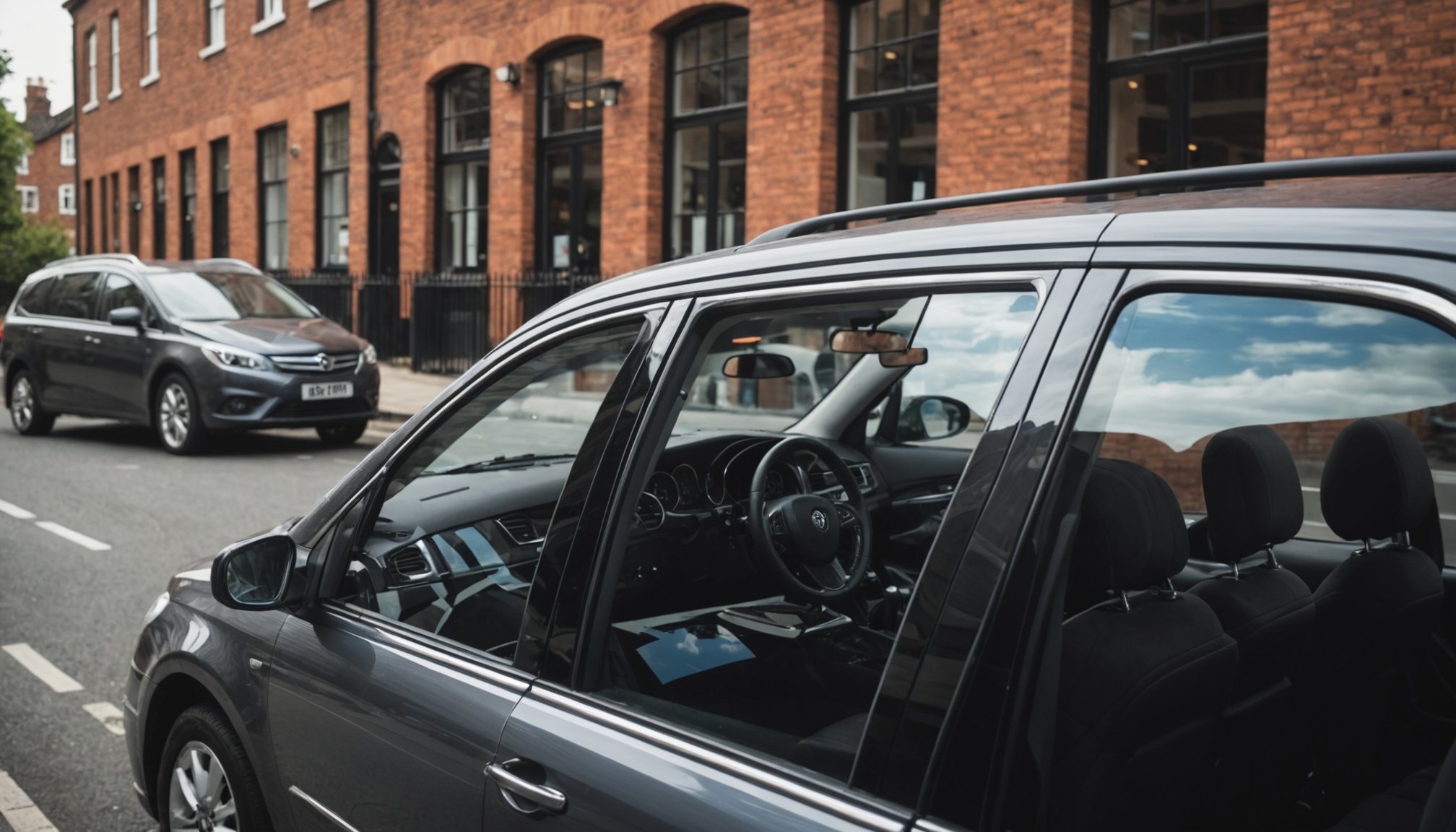Legal Limits for Tinted Windows in the UK
When considering window tints for your vehicle, it is crucial to understand the legal limits set by the UK’s tinted windows regulations. These laws are designed to ensure safety on the roads by maintaining sufficient visibility.
For front side windows adjacent to the driver, the legal tint limit permits a minimum of 70% visible light transmission. Meanwhile, the windscreen must allow at least 75% of light through. However, the laws for rear window tints are more lenient, permitting any level of darkness. This is because the risk to visibility is considerably lower compared to front windows.
Topic to read : Crucial safety tips for setting up a high-performance audio system in your uk car
Different vehicle types may be subject to varying legal limits. For instance, commercial vehicles must adhere to stricter guidelines to ensure the driver’s clear view of the road. It is vital to recognize these distinctions to remain compliant and avoid potential penalties.
Ignoring these legal requirements can lead to serious consequences, such as fixed penalty notices or even more severe fines, depending on the degree of non-compliance. Adhering to the UK’s tinted windows regulations not only protects you from fines but also ensures the safety of all road users. Always verify that window tints comply with these regulations to maintain road safety.
This might interest you : Ultimate guide to flawlessly detailing your car”s engine bay for uk car shows
Legal Limits for Tinted Windows in the UK
Different regions across the UK, such as Scotland, Wales, Northern Ireland, and England, each have their own regional regulations on window tints. It is important to note these differences to remain compliant wherever you drive.
In Scotland and Wales, enforcement of these regulations tends to be consistent with national guidelines. However, vehicle owners in Northern Ireland may face stricter enforcement, with local authorities prioritizing road safety. England follows the UK-wide regulations, but enforcement can vary based on local policies.
Several exemptions or exceptions exist, such as where heavy-duty vehicles might require different tint levels for functional reasons. In each region, you must ensure your vehicle adheres to UK regional regulations and any region-specific rules.
Being aware of these variances helps in avoiding unintended non-compliance. Failing to comply, especially in regions with strict enforcement, could lead to immediate penalties. Knowing what is acceptable in each region is crucial for vehicle owners who frequently travel across the UK.
Staying informed about different tint regulations across the UK ensures that from Scotland to England, and Wales to Northern Ireland, you maintain legal and practical window tint levels.
Legal Limits for Tinted Windows in the UK
Understanding the legal limits for tinted windows across the UK is essential to ensure compliance and safety. The UK tinted windows regulations primarily dictate that for front side windows, at least 70% visible light must pass through, while the windscreen requires a heftier 75% light transmission. It’s critical to adhere to these legal thresholds to avoid substantial penalties or fines.
Commercial vehicles might face particularly stringent regulations. This is because ensuring the driver’s clear sight of the road remains a top priority in high-traffic industrial sectors. The lack of transparency concerning tinted windows can lead to hazardous situations, making adherence to these legal limits non-negotiable.
Apart from facing fines, having non-compliant tints could also involve rectifying modifications at your own expense. Therefore, understanding and respecting these UK tinted windows regulations is not merely a legal obligation but a commitment to maintaining road safety for yourself and others. While rear windows can be darker due to relaxed regulations, routine checks are advisable. Ensuring your tints meet requisite standards protects you from legal ramifications and supports safer driving conditions.
Relevant Legislation Governing Window Tints
Understanding the legislation that governs tinted windows in the UK is crucial for vehicle owners. Two principal acts, the Road Vehicles (Construction and Use) Regulations 1986 and the Road Traffic Act 1988, lay the groundwork. These laws define the maximum permissible tint percentages and specify consequences for violations. For instance, any tint obstructing more light than allowed is deemed non-compliant under these regulations.
The Road Vehicles (Construction and Use) Regulations 1986
This regulation mandates that front windows must allow a significant amount of light through. Enforcement revolves around the allowance of 70% visible light through front windows and 75% through windscreens. Non-compliance here could imply hefty fines and possible driving restrictions.
The Road Traffic Act 1988
This act impacts all aspects of vehicle use, including the enforcement of tinted windows law. It reinforces compliance by allowing police to check the light transmission of windows randomly during vehicle stops. Penalties under this act include immediate fines or requiring the removal of the tint.
Additional Legislative Considerations Across the UK
It is important to note updates and changes in legislation. Regional adjustments can occur, making it imperative to stay informed on shifting laws. Violating these regulations implies not just fines, but potential compromise to road safety. Hence, regular review of UK tinted windows regulations is essential.
Potential Penalties for Non-Compliance
Having non-compliant window tints on your vehicle can lead to serious repercussions. Penalties typically include fines and mandatory removal of the offending tints to adhere to stricter enforcement measures set by law. Depending on the enforcement practices of the region, you might encounter roadside checks that could immediately identify and penalize infractions.
Law enforcement agencies often employ light transmission meters to accurately assess compliance with regulations during stops. If your vehicle’s windows fall short of the legal limits, expect possible fixed penalties, which could escalate to more significant fines or even vehicle use restrictions if ignored repeatedly.
Consistent enforcement ensures that public safety is prioritised, making routine checks not just advisable, but essential for vehicle owners. Regular maintenance and adherence to UK tinted windows regulations mitigate the risk of such penalties. Engaging with reputable professionals for installation—and verifying the legal limits—can help avoid these consequences. This proactive approach secures peace of mind and promotes safer driving environments, aligning with national road safety goals.
Compliance Guidelines for Vehicle Owners
Choosing the right compliant window tints for your vehicle ensures you stay within the UK tinted windows regulations. It’s essential to begin with a clear understanding of these legal limits and adhere to recommended practices. First, prefer seeking advice from professionals who specialise in safe and legal installations. They can provide valuable insights on materials that guarantee compliance with UK legal limits.
Recommended Practices
- Consultation: Engage with reputable experts in window tinting. Their expertise aids in selecting tints that avoid exceeding permitted visible light transmission percentages.
- Installation: Choose professional services for window tinting. Proper installation ensures fewer chances of violating legal limits, mitigating unnecessary penalties.
Checklist for Compliance
- Verify Tint Levels: Use tools like light transmission meters to check your window tints before any legal inspection.
- Review Documentation: After installation, ensure that you receive appropriate documentation indicating your tints meet UK regulations.
- Frequent Checks: Conduct routine checks on your vehicle’s tints, especially if you travel frequently between UK regions, as local enforcement may vary.
By following these guidelines, vehicle owners can confidently navigate the complexities of tinted windows regulations, ensuring both compliance and road safety.
Visual Aids and Examples
Understanding the difference between compliant tints and non-compliant tints is crucial for vehicle owners who aim to avoid penalties. Visual comparisons can be an effective tool in recognising how varying levels of tint align with UK tinted windows regulations.
Examples of Compliant Window Tints
Compliant window tints allow plenty of light to enter, meeting the legal thresholds of at least 75% visible light through the windscreen and 70% for front windows. These tints are usually lighter, ensuring the driver has a clear view while adhering to legal stipulations.
Examples of Non-Compliant Window Tints
Non-compliant tints are noticeably darker, hindering the necessary light transmission set by law. These tints can obscure the driver’s vision, posing a safety risk and resulting in fines. Regularly assessing your vehicle’s tint against legal limits helps in maintaining compliance.
Resources for Verification of Tint Levels
Manufacturers often provide specifications detailing tint levels, which help in ensuring selections meet legal standards. Additionally, online resources offer reference images and tools to evaluate your vehicle’s window tints. Using reputable gauges or consulting experts further verifies compliance, enabling informed decision-making regarding window tints.











